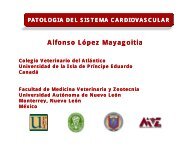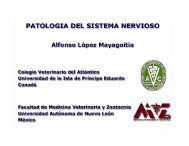Skin Lecture 4
Skin Lecture 4
Skin Lecture 4
Create successful ePaper yourself
Turn your PDF publications into a flip-book with our unique Google optimized e-Paper software.
Pathology of the<br />
Integumentary System<br />
<strong>Lecture</strong> 4<br />
Parasitic / Immune<br />
(web)<br />
Paul Hanna Fall 2012
PARASITIC SKIN DISEASES<br />
• cause disease directly by: inflammation<br />
blood sucking<br />
toxin injection<br />
results: annoyance<br />
reduced production<br />
unthrifty / blemished hides<br />
• cause disease indirectly by:<br />
important vectors eg WNV, RMSF, Lyme, Leishmaniasis, dirofilariasis<br />
predispose to pyoderma, myiasis or local viral infections<br />
Diagnosis<br />
• history & clinical signs (esp. pruritus) / lesions<br />
• parasite ID<br />
• skin biopsy
MITES<br />
Demodectic Mange<br />
• normal microfauna, neonates acquire from dam.<br />
• see mainly in dogs with genetic predisposition &/or immunodeficiency<br />
Localized form<br />
young dogs (3-10 months), usually self-limiting.<br />
1 to 5 patchy areas of alopecia; variable erythema, scaling & hyperpigmentation<br />
Generalized form<br />
in juveniles following localized form (~10%)<br />
in older dogs internal disease &/or immunosuppression<br />
massive proliferation of mites folliculitis/furunculosis, 2 o pyoderma
Localized Demodecosis<br />
With localized demodecosis can see focal<br />
areas of alopecia, erythema and/or<br />
hyperpigmentation, and comedones.
Generalized Demodecosis<br />
Generalized demodecosis with secondary pyoderma, note widespread alopecia with scaling / crusting
note: perifolliculitis with<br />
demodex mites in<br />
follicular lumina.<br />
Demodex mites<br />
from scrapings
Sarcoptic Mange (Scabies)<br />
• pigs > dogs > ruminants, horses<br />
• highly contagious, host-adapted varieties (eg. S. scabiei var. suis)<br />
• zoonotic; humans readily parasitized, but usually limited reaction to animal varieties<br />
• lesions due to: mechanical damage from burrowing<br />
irritation from mite saliva and excreta<br />
hypersensitivity to mite products
note: alopecia & excoriations<br />
note: marked crusting within ear canal of pig<br />
note: alopecia, lichenification,<br />
hyperpigmentation
Pruritic papules on human arm (above) which<br />
is a typical skin reaction to animal mites<br />
note: mite tunneling<br />
within cellular crust<br />
Note severe excoriations / crusting on a human hand due<br />
to hypersensitivity reaction to an animal variety of mite.
Notoedric Mange<br />
Cheyletiellosis<br />
Otodectic Mange<br />
Psoroptic Mange<br />
Chorioptic Mange<br />
Psorergatic Mange<br />
Trombiculidiasis<br />
note: marked crusting and excoriation on face<br />
of cat with Notedric mange.
TICKS<br />
• divided into 2 families, ie hard ticks (Ixodidae) and soft ticks (Argasidae)<br />
• vectors for many viral, bacterial & protozoal diseases of domestic animals<br />
• can also cause local skin damage, anemia or paralysis
FLEAS<br />
• most important cause of skin disease in small animals (C. felis & C. canis)<br />
• can cause pruritus / irritation skin, anemia, infectious disease vectors, HS reactions<br />
• clinically, can see: asymptomatic carriers<br />
flea-bite dermatitis<br />
flea allergy dermatitis<br />
Flea dirt (ie flea feces composed of dried digested blood), may be more readily found than the fleas themselves
LICE (PEDICULOSIS)<br />
Sucking lice - feed on blood and tissue fluids<br />
Biting lice - feed on exfoliated epithelium and debris<br />
Note many lice with<br />
numerous eggs (nits)<br />
attached to hairs.
FLIES<br />
vetgrad.co.uk<br />
• cause : annoyance (“fly-worry”)<br />
localized skin damage / pruritus, (fly bite dermatitis)<br />
+/- hypersensitivity (eg Culicoides HS)<br />
direct toxicity (eg black fly toxin)<br />
anemia<br />
vectors for infectious agents<br />
myiasis<br />
Feline Mosquito-bite dermatitis / hypersensitivity.<br />
See characteristic crusted papules on the bridge of<br />
the nose, pinnae and perauricular regions.<br />
FIGURE 5-92 (Sm An Derm) Fly Bite Dermatitis. Alopecia<br />
& crusting (hemorrhagic) on the ear tip of a dog. Note<br />
the similarity to scabies and autoimmune skin disease.
FLIES<br />
Black fly bite on glabrous skin of a dog’s abdomen. Some<br />
animals show these characteristic annular lesion of a central<br />
pale zone of edema, with peripheral erythematous rim
FLIES<br />
Myiasis - infestation of living animals tissues with fly larvae (maggots / grubs)<br />
Warbles (Hypoderma)<br />
• primarily cattle, occasionally horses & others<br />
• eggs laid on hair (esp legs) larva burrow into skin migrate & overwinter in<br />
epidural fat or esophagus in spring migrate to subQ along back and form nodules<br />
mature larvae emerge & pupate on soil<br />
eg damaged hide due to warble fly larvae in subQ nodules along the back of cattle
FLIES<br />
Myiasis - infestation of living animals tissues with fly larvae (maggots / grubs)<br />
Cuterebriasis<br />
• typically small wild mammals, but occasionally infest cats and others<br />
FIGURE 5-84 (Sm An Derm Atlas) Cuterebra. Erythema and<br />
fibrosis surround the breathing hole of the Cuterebra on the<br />
neck of an adult cat. A purulent exudate is common.<br />
FIGURE 5-85 (Sm An Derm Atlas) Cuterebra. The<br />
Cuterebra has been removed with hemostats. The lesion<br />
consists of a fibrosed tunnel with a purulent exudate.
HELMINTH DISEASE<br />
Cutaneous larval migration<br />
• adults live in non-cutaneous sites while larval stages migrate through skin<br />
Cutaneous Habronemiasis (“summer sores”)<br />
• due to aberrant deposition and migration of Habronemia & Draschia spp larvae<br />
• normally larvae deposited near mouth swallowed develop in stomach wall<br />
• when larvae deposited on moist skin / wounds by flies ulcerative dermatitis<br />
note: ulcerated / nodular lesions on lip and periocular regions (r/o sarcoid, squamous cell carcinoma)
Ulcerated lesion on fetlock (above) and multiple ulcerated<br />
papules and nodules involving the prepucial orifice and<br />
urethral process (below - from Eq Derm 2 nd ed)<br />
On histologic examination there is typically eosinophilic<br />
granulomatous inflammation, which often contain<br />
segments of Habronema larva within areas of necrosis.
HELMINTH DISEASE<br />
Filarial Dermatitis<br />
adults or microfilaria spend some time in the skin<br />
Onchocerciasis<br />
Stephanofilariasis<br />
Dirofilarial (heartworm) dermatitis<br />
Equine cutaneous ochocerciasis.<br />
Adults O. cervicalis live in nuchal<br />
ligament and microfilaria in dermis.<br />
The prevalence of infection is high in<br />
North America, but most horses don’t<br />
have lesions. There is strong evidence<br />
that those horses that develop skin<br />
lesions have individual (sporadic)<br />
hypersensitivity to microfilarial<br />
antigens. The characteristic lesions<br />
are areas of alopecia, scaling / crusting<br />
and leukoderma.
PROTOZOAL DISEASES<br />
Sarcocystosis<br />
Leishmaniasis<br />
Besnoitiosis<br />
Fig 6-25 Leishmaniasis. (Atlas Sm An Derm) Alopecia and crusting on the<br />
nose and periocular skin of a Labrador. Note the mild nature of the lesions.
IMMUNE-MEDIATED SKIN DISEASE<br />
HYPERSENSITIVITY REACTIONS<br />
Definition<br />
in response to normally harmless foreign compounds (Ag’s)<br />
most cutaneous HS's are mediated by types I or IV HS reactions<br />
pruritus is a feature common to most HS's
HYPERSENSITIVITY REACTIONS<br />
Diagnosis<br />
• history and clinical signs / lesions (esp pruritus)<br />
• skin biopsy (mostly non-diagnostic)<br />
• intradermal skin testing, elimination of Ag’s, response to therapy
1. ATOPIC DERMATITIS<br />
• common in dogs (genetic/familial); less in cats and horses<br />
• variety of predominately transepidermally absorbed allergens (+/- seasonal)<br />
• complex type I (+/- IV) HS to normally innocuous exogenous Ag's.<br />
• possible dysfunction of Th2 cells with overproduction of specific IgE<br />
• mast cell degranulation pruritus self-trauma
Gross<br />
• pruritus self-trauma erythema, excoriation, alopecia (esp face / feet / abdomen)<br />
hyperpigmentation & lichenification
Histology<br />
• early perivascular / interstitial dermatitis<br />
• later hyperplastic P/I dermatitis; often 2 o pyoderma / Malasseziasis<br />
Differential Diagnosis<br />
• histology non-diagnostic, R/O other allergies and ectoparasitism<br />
note: edema of<br />
superfical dermis<br />
and mild<br />
perivascular /<br />
interstitial infiltrate<br />
of inflammatory cells
2. FLEA ALLERGY DERMATITIS (Flea-bite Hypersensitivity)<br />
most common hypersensitivity of cats and dogs, in flea endemic areas<br />
combination of types I & IV HS to antigens in flea saliva<br />
once sensitized, few fleas are needed for severe reaction.<br />
intense pruritus self trauma / secondary infections<br />
Gross<br />
primary lesion is an erythematous papule or wheal<br />
self-trauma alopecia, excoriation & crusts<br />
chronicity hyperpigmentation & lichenification
note: excoriation / crusts / early<br />
lichenification of lateral thorax &<br />
lumbosacral area
note: alopecia / excoriations (above) and mostly just<br />
alopecia due to excessive “grooming” (below)<br />
Crusted papules of “miliary dermatitis”<br />
(note millet seeds on bread in top pic)
Histology<br />
• P/I dermatitis with eosinophils & mast cells early and later mononuclear cells<br />
• may see spongiosis &/or eosinophilic microabscesses ("nibbles")
3. SOME OTHER HYPERSENSITIVITY REACTIONS<br />
Urticaria (hives or wheals) / Angioedema (edematous swellings)<br />
Allergic Contact Dermatitis [Contact HS]<br />
Food Hypersensitivity (Food Allergy)<br />
Equine Insect (Culicoides) Hypersensitivity<br />
Etc.
SOME OTHER HYPERSENSITIVITY REACTIONS<br />
Allergic Contact Dermatitis [Contact HS]<br />
Occurs following prolonged contact (sensitization) with the offending<br />
allergen (eg plants, cleaners, synthetic carpets plastic dishes, rubber<br />
chew toys, etc. Early lesions of erythema, papules / plaques and<br />
vesicles are seen in the areas of contact (esp sparsely haired regions).
AUTOIMMUNE REACTIONS<br />
when autoAb’s or T cells react against self Ag’s<br />
most have hereditary predisposition; rare in domestic animals (dogs > horses, cats)<br />
Pemphigus<br />
• autoAb’s to desmosomal Ag's (desmogleins) loss of cohesion & inflammatory<br />
mediators acantholysis intraepidermal pustules with acantholytic cells<br />
Acantholysis = loss of cohesion between keratinocytes
Pemphigus foliaceous<br />
Note: immune staining of deposits of<br />
intracellular autoimmune IgG in<br />
the upper epidermal region.<br />
Note: subcorneal pustule with<br />
numerous acantholytic cells<br />
admixed with neutrophils
Pemphigus foliaceus<br />
The primary lesion is superficial pustules, but they are often obscured by hair<br />
coat or have ruptured because they are fragile.
Pemphigus foliaceous<br />
Pemphigus foliaceous, dog.<br />
Note, widespread alopecia, scaling, crusting<br />
Note thick crusts on footpads of dog<br />
with pemphigus folicaceous. Crusts<br />
result from adherence of the content of<br />
ruptured pustules to the skin surface.
Pemphigus foliaceous<br />
note: numerous pustules<br />
and epidermal collarettes
Bullous pemphigoid<br />
• autoantibodies against BPAg2 in hemidesmosome subepidermal vesicles/pustules<br />
Note subepidermal vesicle, with complete<br />
separation of the intact epidermis (including<br />
basal layer) from the dermis.
Bullous pemphigoid<br />
grossly see vesicles / bullae which often<br />
rupture to leave ulcers;<br />
Fig 8-45 (Atlas Sm An Derm) Bullous Pemphigoid.<br />
Severe ulcerative dermatitis on the abdomen. The punctate<br />
lesions coalesced to form large ulcerative lesions. Note the<br />
similarity to erythema multiforme, cutaneous drug reactions,<br />
and vasculitis.
Discoid (cutaneous) lupus erythematosus<br />
• UV light alters keratinocyte Ag’s autoimmune reaction interface dermatitis<br />
See interface dermatitis, with dense lichenoid band of lymphocytes &<br />
plasma cells, apoptotic basal keratinocytes and pigmentary incontinence<br />
Fig 9-39 (Eq Derm, 2 nd ed) Note apoptotic keratinocyte<br />
(upper black arrow) and melanophage (lower black arrow).
Discoid (cutaneous) lupus erythematosus<br />
Note, alopecia, erythema, erosion / ulceration,<br />
crusting, & depigmentation of nasal planum region.<br />
Same dog following treatment; note resolution<br />
of inflammation but depigmentation remains.
AUTOIMMUNE REACTIONS<br />
Diagnosis<br />
history and clinical signs / lesions<br />
skin biopsy of fresh lesions<br />
immunologic tests – esp IHC
SOME OTHER IMMUNE-MEDIATED DISORDERS<br />
Immune-mediated Vasculitis<br />
Erythema Multiforme<br />
Toxic Epidermal Necrolysis<br />
Vogt-Koyanagi-Harada-like syndrome<br />
Plasma Cell Pododermatitis<br />
Cutaneous Amyloidosis<br />
Infarction of facial skin following<br />
immune-mediated vasculitis
















